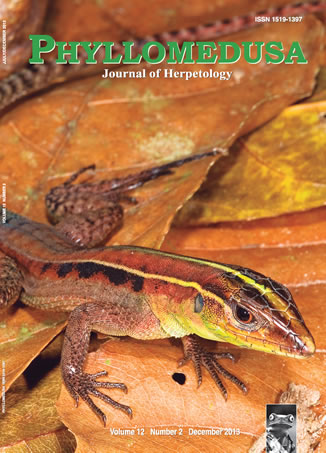Cytogenetic study of Leptodactylus fuscus and L. latrans (Anura: Leptodactylidae) from the semiarid Brazilian Caatinga scrublands
DOI:
https://doi.org/10.11606/issn.2316-9079.v12i2p125-133Keywords:
Amphibians, Chromosomes, C´bands, Ag-NORAbstract
Frogs in the family Leptodactylidae have diploid chromosome numbers ranging from 2n = 18 to 2n = 26, although there is a predominance of 2n = 22 karyotypes. In the present sudy, 52 specimens of Leptodactylus latrans were obtained from three muncipalities (Carira. Poço Redondo, and Tobias Barreto) of the Brazilian state of Sergipe for karyotype analysis using conventional Giemsa staining techniques, and C- and Ag-NOR banding of the chromosomes obtained from the intestinal epithelium. The results of this study show that the individuals analyzed have highly similar karyotypes, with no evidence of any pronounced species-specific markers. However, some differences were observed in the chromosome morphology and C-bands in comparison with the karyotypes described previously for these species, with may represent intraspecific geographic variation in both taxa.Downloads
Download data is not yet available.
Downloads
Published
2014-02-10
Issue
Section
Articles
License
All material originally published in Phyllomedusa belongs to Escola Superior de Agricultura Luiz de Queiroz - Universidade de São Paulo. All contents are under a license of Creative Commons BY-NC-ND.How to Cite
Oliveira, B. de, Moares, M. S., Dertônio, D., Faria, R. G., & Pantaleão, S. M. (2014). Cytogenetic study of Leptodactylus fuscus and L. latrans (Anura: Leptodactylidae) from the semiarid Brazilian Caatinga scrublands. Phyllomedusa: Journal of Herpetology, 12(2), 125-133. https://doi.org/10.11606/issn.2316-9079.v12i2p125-133



 Impact Factor (JCR): 0.600
Impact Factor (JCR): 0.600 CiteScore: 1.0
CiteScore: 1.0